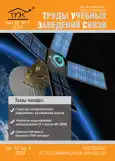Подход к обнаружению вредоносных ботов в социальной сети ВКонтакте и оценка их параметров
- Авторы: Чечулин А.А.1,2, Коломеец М.В.3
-
Учреждения:
- Санкт-Петербургский Федеральный исследовательский центр Российской академии наук
- Санкт-Петербургский государственный университет телекоммуникаций им. проф. М.А. Бонч-Бруевича
- Ньюкаслский университет
- Выпуск: Том 10, № 2 (2024)
- Страницы: 92-101
- Раздел: ИНФОРМАЦИОННЫЕ ТЕХНОЛОГИИ И ТЕЛЕКОММУНИКАЦИИ
- URL: https://journal-vniispk.ru/1813-324X/article/view/255949
- EDN: https://elibrary.ru/ZTCHLS
- ID: 255949
Цитировать
Полный текст
Аннотация
Об авторах
А. А. Чечулин
Санкт-Петербургский Федеральный исследовательский центр Российской академии наук; Санкт-Петербургский государственный университет телекоммуникаций им. проф. М.А. Бонч-Бруевича
Email: chechulin.aa@sut.ru
ORCID iD: 0000-0001-7056-6972
SPIN-код: 1632-0938
М. В. Коломеец
Ньюкаслский университет
Email: maksim.kalameyets@newcastle.ac.uk
ORCID iD: 0000-0002-7873-2733
SPIN-код: 1780-9045
Список литературы
- Cresci S. A decade of social bot detection // Communications of the ACM. 2020. Vol. 63. Iss. 10. PP. 72–83. DOI:10.1145/ 3409116
- Samoilenko S.A., Suvorova I. Artificial intelligence and deepfakes in strategic deception campaigns: The US and Russian experiences // In: The Palgrave Handbook of Malicious Use of AI and Psychological Security. Cham: Springer International Publishing, 2023. PP. 507–529. doi: 10.1007/978-3-031-22552-9_19
- Yang K., Menczer F. Anatomy of an AI-powered malicious social botnet // arXiv preprint arXiv:2307.16336.2023. doi: 10.48550/arXiv.2307.16336
- Gilani Z., Farahbakhsh R., Tyson G., Wang L., Crowcroft J. Of bots and humans (on twitter) // Proceedings of the International Conference on Advances in Social Networks Analysis and Mining. (New York, USA, 31 July 2017). Association for Computing Machinery, 2017. doi: 10.1145/3110025.3110090
- Orabi M., Mouheb D., Al Aghbari Z., Kamel I. Detection of bots in social media: a systematic review // Information Processing and Management. 2020. Vol. 57. Iss. 4. P. 102250. doi: 10.1016/j.ipm.2020.102250
- Коломеец М.В., Чечулин А.А. Метрики вредоносных социальных ботов // Труды учебных заведений связи. 2023. Т. 9. № 1. С. 94−104. doi: 10.31854/1813-324X-2023-9-1-94-104. EDN:HEFHFR
- Zegzhda P.D., Malyshev E.V., Pavlenko E.Y. The use of an artificial neural network to detect automatically managed accounts in social networks // Automatic Control and Computer Sciences. 2017. Vol. 51. Iss. 8. PP. 874–880. doi: 10.3103/S0146411617080296. EDN:UYCEUW
- Samokhvalov D.I. Machine learning-based malicious users' detection in the VKontakte social network // Proceedings of the Institute for System Programming of the RAS. 2020. Vol. 32. Iss. 3. PP. 109–117. doi: 10.15514/ISPRAS-2020-32(3)-10
- Kaveeva A.D., Gurin K.E. Artificial VKontakte profiles and their impact on the social network of users // Journal of Sociology and Social Anthropology. 2018. Vol. 21. Iss. 2. PP. 214–231. doi: 10.31119/jssa.2018.21.2.8. EDN:XZOGHB
- Kolomeets M., Tushkanova O., Levshun D., Chechulin A. Camouflaged bot detection using the friend list // Proceedings of the 29th Euromicro International Conference on Parallel, Distributed, and Network-Based Processing (PDP, Valladolid, Spain, 10–12 March 2021). IEEE, 2021. PP. 253–259. doi: 10.1109/PDP52278.2021.00048. EDN:ZDXFHS
- Skorniakov K., Turdakov D., Zhabotinsky A. Make Social Networks Clean Again: Graph Embedding and Stacking Classifiers for Bot Detection // Proceedings of the Workshops, co-located with 27th ACM International Conference on Information and Knowledge Management (CIKM, Torino, Italy, 22 October 2018). ISP RAS, 2019. Vol. 2482. EDN:IHZECD
- Kolomeets M. MKMETRIC2022 – dataset with VKontakte bot identifiers and their metrics // guardeec/datasets. 2022. URL: https://github.com/guardeec/datasets#mkmetric2022 (Accessed 20.04.2024)
- Zhou Z., Guan H., Bhat M., Hsu J. Detecting Fake News with NLP: Challenges and Possible Directions. 2018. URL: https://meghu2791.github.io/Fake_News_Detection.pdf (Accessed 20.04.2024)
Дополнительные файлы






